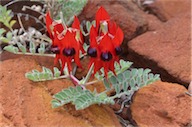In Flower This Week
A news sheet prepared by a Gardens' volunteer.
Numbers before each plant refer to temporary IFTW labels in the gardens.
Numbers in square brackets [ ] refer to garden bed Sections. Plants in flower are in bold type.
View past issues of 'In Flower This Week'.
2 - 15 March 2016
Swainsona
formosa click for larger image |
Today we will walk from the Visitor Information Centre (VIC) along the Main Path
- As you leave the VIC look left to see in a pot Pilidiostigma rhytispermum [Section 221], or Small-leaved Plum Myrtle, which is a small shrub with cream cup-like flowers and bright green leaves. It is native to the wet eucalypt forest of southeastern Queensland.
- Turn to your right to see Swainsona formosa [Section 221] in a pot. Commonly known as Sturt's Desert Pea, it has pale green leaves and bright red pea flowers with shiny black centres or bosses. It is the state flower of South Australia and is found widely distributed in dry inland Australia.
- Further on your right is Corymbia 'Summer Beauty' [Section 174], a small bush with long green leaves, attractive buds and glorious pink fluffy flowers.
- Close by, also on your right, is Corymbia 'Summer Red' [Section 174], another spectacular small eucalypt with bright red flowers and beautiful bud formations.
- Cross the bridge and go past the café to see on your left Syzygium australe [Section 131], a tall shrub with very shiny leaves and powderpuff white flowers. The pear-shaped red or purple fruit, known as Riberries, mature from December to February. The species is native to the subtropical rainforests of New South Wales and Queensland.
- Further on your left is Epacris longiflora 'Nectar Pink' [Section 131], a very floriferous small shrub covered in slender pink bell flowers with white tips.
- Turn left up the Main Path, go up the hill, and bear right to see on your left Banksia spinulosa 'Birthday Candles' [Section 30]. It is a dense bright green bush with attractive needle foliage and short yellow cones with rusty red styles.
- On your right is Grevillea 'Bronze Rambler' [Section 30], which is a popular low groundcover with divided foliage and red toothbrush-like flowers. Grevillea 'Bronze Rambler' originated in cultivation in the garden of W. and L. Wilson, Moe South, Victoria. It is said to be a cross between Grevillea rivularis and G. 'Poorinda Peter'.
- Also on your right, in a pot, is Banksia baxteri [Section 30] or Baxter's Banksia with triangular grey-green foliage and terminal bright yellow flowers used for floriculture. This plant occurs in southwestern Western Australia near the Stirling Ranges.
- Cross the road to see on your right Banksia marginata 'Cape Patterson Dwarf' [Section 26], an unusual small version of our common local Banksia marginata. It has bright yellow cones on silver-backed foliage.
- Further on your right is Grevillea sericea [Section 26], with pink spider flowers on a long-flowering open bush. This plant is endemic to New South Wales.
- Also on your right is Banksia conferta subsp. penicillata [Section 26], or Newnes Plateau Banksia, a small tree covered in short green cones with grey ends to the flowers and a velvety brown "nose" protruding from the top of the cone. It is found in a restricted area near Lithgow, New South Wales.
- On your left is Grevillea manglesii subsp. ornithopoda [Section 24], or Birdsfoot Grevillea, a large open bush with white pincushion flower heads all along the stems. It is native to Western Australia.
- Also on your left is Banksia ericifolia 'Red Clusters' [Section 25], a small tree with green heath-like foliage and very large orange-red cones.
- Cross the road into the Sydney Region Flora to see on your left Medicosma cunninghamii [Section 112], a small tree with dark green foliage and four-petalled white cup-like flowers. Known as Pinkheart or Bonewood, it is a rainforest tree found in eastern Australia from northern New South Wales to Maryborough, Queensland.
Rosalind Walcott
![Director of National Parks [logo]](../../../../images/dnp_90px.gif)







